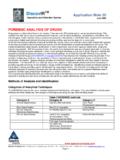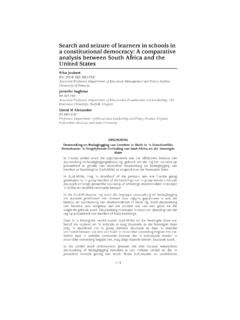Transcription of Prosecutor’s Guide to Dogfighting Cases
1 Prosecutor's Guide to Dogfighting Cases 1. Why Prosecute Dogfighting ? Dogfighting is a crime. Dogfighting Cases have been prosecuted in the since the arrest of Kit Burns in New York City in 1868. The 2007 prosecution of NFL star Michael Vick on federal and state charges related to Dogfighting activity has focused increased attention on this blood sport . Dogfighting is illegal in all 50 states and the District of Columbia, Puerto Rico, and the Virgin Islands. As of 2009, Dogfighting is a felony in all states. In most states, the possession of dogs for the purpose of fighting is also a felony offense. Being a spectator at a dogfight is currently a felony in about half the states and a misdemeanor in most remaining states. The federal Animal Fighting Prohibition Enforcement Act (2007) provides for felony penalties for interstate commerce, import and export relating to commerce in fighting dogs, fighting cocks and cock fighting paraphernalia.
2 Each violation can result in up to three years in jail and a $250,000 fine. Dogfighting can be a gateway crime . Many communities report growing involvement of juvenile offenders in Dogfighting , often as a part of gang involvement. The sense of power and control gained from having an aggressive dog, as well as the potential financial gain, can lure juveniles into an underground scene that often includes other criminal activities. Dogfighting is associated with many other crimes In addition to the animal cruelty and illegal gambling that are at the core of Dogfighting activity, virtually all dogfight raids involve the discovery and seizure of illegal drugs and about two-thirds result in the seizure of illegal weapons. Such raids often result in the arrest of many offenders with outstanding warrants. Dogfighting is also frequently associated with violent crimes, including assaults and homicides and has increasingly been associated with gang-related activities.
3 Dogfighting destabilizes communities Dogfighting is a classic example of a broken-window crime. The evidence of it's presence in an area may be very visible, particularly in the case of street fighting, but the difficulty of mounting an effective law enforcement response may create the perception that no one cares about the threats this crime presents to the community. 1 Combating Dogfighting 2010. 2. What makes Dogfighting prosecutions difficult? When suspected Dogfighting activities have been discovered by law enforcement or humane agencies, the successful pursuit of such operations presents special challenges to prosecutors: Dogfighting Cases frequently involve multiple defendants A Detroit College of Law analysis of Dogfighting raids indicated that the number of arrests in such actions ranged from 1 to 123, with an average of 20 arrests per raid. Prosecutors need to be prepared to deal with multiple defendants, many of whom are likely to have past criminal records from a number of states.
4 Dogfighting raids usually involve multiple law enforcement units and result in multiple charges Almost all actions against dogfighters involve the participation of local and state police, along with animal control or state humane officers, gang units, narcotics units and others. Federal agencies may also be involved (FBI, DEA, USDA). It is essential that the activities of these various agencies are well-coordinated. In addition, such actions are likely to result in multiple charges for violations at the local, state and federal level and the various agencies responsible for enforcement of these laws must coordinate their actions. Virtually all raids involve the discovery and seizure of considerable quantities of illegal drugs and many raids uncover production or growing facilities. Dogfighting actions involve living evidence. The dogs involved in Dogfighting activities are both victims and evidence of the crime. Recent raids have resulted in the seizure of from 1 to nearly 500 dogs, with an average of 35 dogs per case.
5 They often have special medical and behavioral needs that must be met. Housing, assessment and disposition of fighting dogs can be complicated and expensive. Maintaining animals as evidence for a lengthy period is not only costly for local humane organizations or municipal animal control agencies, but often detrimental to the well-being of the animals. Arrangements for the care and housing of any animals to be seized should be made in advance of any operation. In addition, arrangements should be made for medical assessment and possible behavioral evaluation. Nearly all states have provisions within their animal cruelty laws providing for the seizure of animals being cruelly treated or neglected. Some states require that a veterinarian be consulted to determine if seizure is in the best interests of the animals. Such input is desirable even when not specifically required by law. Such seizures can place an enormous burden on the responding agencies.
6 An animal fighting investigation may involve dozens to hundreds of animals needing immediate and long-term care. The special requirements for animal care in Dogfighting Cases demand that these Cases be moved as quickly as possible through the system. Prolonging proceedings is problematic 2 Combating Dogfighting 2010. for all concerned. The animals can suffer additional stress, disease or harm from improper or prolonged confinement. In some Cases , animals cannot receive needed medical treatment without the owner's consent or willingness to surrender ownership, which may be withheld. The responding agency can accumulate huge costs in providing long-term housing and care for animals that are likely to be returned, adopted or euthanized at the conclusion of proceedings. Dogfighting actions often involve substantial asset seizures. About 25% of raids result in the seizure of other assets including vehicles, cash, medical supplies, real estate and other property.
7 The involvement of these assets in the conduct of the illegal fighting activity should be well-documented. Dogfighters are often well-funded and well-informed about other prosecutions. The Dogfighting underground is well-connected through publications, Internet communications and word-of-mouth. Fighters follow the arrest and trial of other fighters and any successful defense strategies are quickly disseminated throughout the network. It is important for prosecutors to be well-informed about common defense tactics that are likely to be used. 3. What options are available for housing animals seized in Dogfighting Cases pending trial? Several options may be available to minimize some of the costs and delays associated with prosecuting a Dogfighting case: Voluntary Surrender Owners of animals that are the subject of an animal cruelty or animal fighting prosecution may voluntarily surrender ownership of the animals to an animal control or humane organization either in the best interest of the animals or as part of an initial plea agreement.
8 To avoid future complaints that this surrender was granted under duress, this usually should not be done in the emotional environment of the initial seizure or arrest and should be arranged with the participation of defendant's counsel. Voluntary surrender offers the best opportunity for meeting the immediate needs of the animals without compromising their value as evidence in a prosecution. Declaration of Animals as Abandoned In Cases where animals have been left without proper care and the owner is not in residence, many states allow for the consideration of such animals as abandoned and subject to immediate seizure by appropriate humane, animal control or agricultural authorities. Animals whose owners do not admit to ownership at the time of seizure or do not appear at hearings scheduled to determine disposition may also be considered abandoned in many states. 3 Combating Dogfighting 2010. Declaration of Unfit Owner Several states have procedures in place that do not necessitate a criminal prosecution for animal cruelty, but which may find that an owner is unable or unfit to adequately provide for animals and order other animals be seized and enjoin owner from further possession or custody of other animals.
9 Impound on Premises When an animal abuse or neglect case involves a large number of animals for which there is no suitable site to hold them, it may be appropriate to arrange for an impound on the defendant's premises with provisions for local authorities to provide for feeding, care and medical attention. If animals are to be held in this way, it is important to carefully document each individual animal and, when feasible, to require that each animal be provided with permanent identification ( microchip) to prevent the removal or replacement of seized animals. In the case of animals of high value or at high risk for theft ( fighting dogs), it may be necessary to have full-time law enforcement presence at the scene until the court allows another disposition. Bonding Provisions When animals are not immediately surrendered and local authorities must provide care to maintain them until final disposition, it is often desirable to require defendants to post a bond or security that is intended to compensate agencies providing care and to prevent the adoption or euthanasia of the animal while the case is being prosecuted.
10 About twenty states currently have provisions that either require or allow for such a procedure within their cruelty laws. For those that do not, there is still the option for seeking a court order requiring such a bond in the interests of both the owner and the caretakers of the animals. Usually such bonds are based on a reasonable cost of care per animal per day, payable in advance on a month-by-month basis with failure to comply resulting in forfeiture of the animals. Most other states consider costs of care and treatment a lien on the animal(s) that have been seized, however it is often very difficult for agencies to recover these costs after the disposition of the case. Failure to comply with a court order to post a security bond can trigger either mandatory or discretionary forfeiture of the dogs. Dogs forfeited in fighting Cases may be placed in appropriate sanctuaries, adoptive homes or humanely euthanized. Destruction of fighting animals as contraband Some states consider seized fighting animals to be the equivalent of contraband and allow for their destruction prior to conviction.







